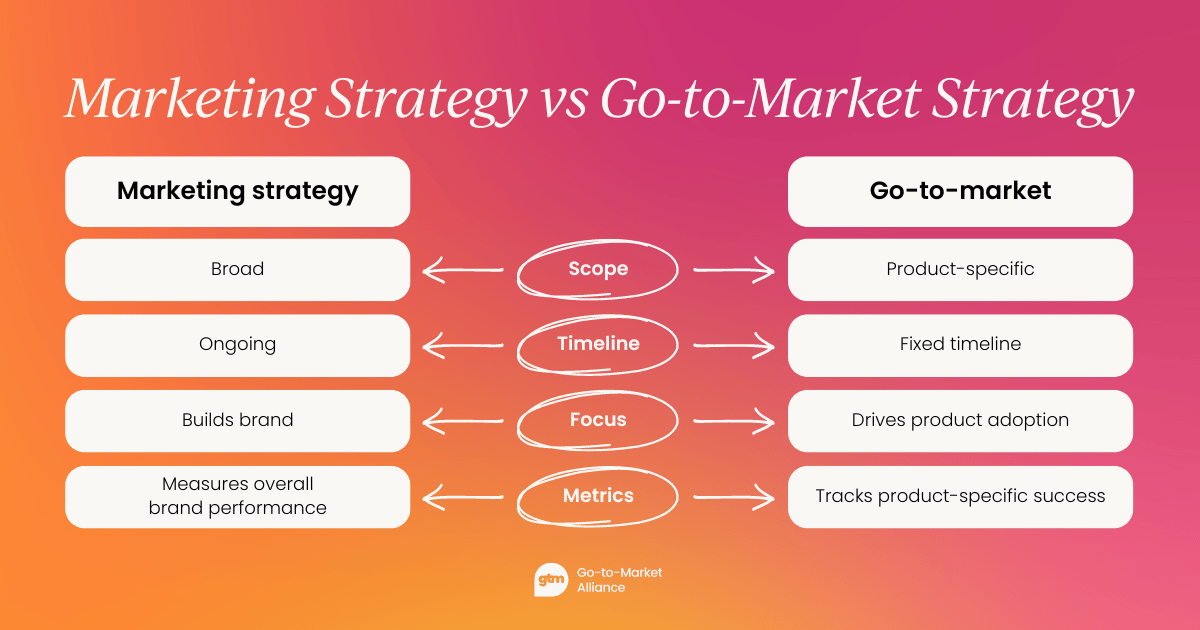Strategy is everything today. But when it comes to marketing and launching a new product, the terms: go-to-market strategy and marketing strategy, often get tossed around interchangeably.
So if you’ve ever wondered, “Aren’t they basically the same thing?” – trust me, you’re not alone. Still, let’s clear up the confusion.
Think of your marketing strategy as the master plan for your brand’s entire journey, the roadmap to guide your overall marketing efforts for the long haul. Whereas, your go-to-market strategy is more like a tactical playbook for your specific goal of launching a new product or breaking into a new market segment.
In this article, we’ll dive even further into both marketing and go-to-market strategies, highlight their key differences, and show you why mastering both is crucial for your brand’s success. Understanding these strategies and their differences will truly give you the competitive edge you deserve.
Let’s dive right in!
Here’s a quick summary of the difference between a marketing strategy and a go-to-market strategy if you’re pressed for time:
A marketing strategy is a long-term, comprehensive plan that guides a company’s overall marketing efforts to achieve business goals and build brand awareness. A go-to-market strategy is a short-term, tactical plan focused on launching a specific product or entering a new market.
What is a marketing strategy?
Imagine you’re planning an epic road trip across the country - you wouldn’t just hop in the car and start driving, would you? No! You’d map out your route, plan stops, and work out ways to make the most of your journey. That’s essentially what a marketing strategy is.
It’s a comprehensive, long-term plan that outlines how you’ll connect with your target audience, showcase your value proposition, and ultimately achieve your business goals. It’s basically the master blueprint for all of your marketing efforts.
What makes up a marketing strategy?
Some of the key components that define a marketing strategy are:
- Brand positioning
What makes your brand unique? How do you want to be perceived in the market? Your positioning helps you to stand out from the crowd and gives your audience a reason to pick you over your competition. Why your road trip and your car?
- Target audience definition
Who are you trying to reach? In a marketing strategy, you need to clearly define your target customers, their needs, preferences, and behaviors. It’s like working out exactly who to invite on your road trip, their favorite snacks, and their dream playlist.
- Market analysis
Just like you’d research the best routes before you start your journey, a marketing strategy does the same, starting with a deep dive into your market. Looking at competitors, target audiences, market trends, and everything in between.
- Marketing mix
Remember the 4 Ps from Marketing 101? You always need to think about product, price, place, and promotion. What are you offering, how much will it cost, where can people find it, and how will you spread the word?
- Execution and goals
Every road trip needs clear destinations and checkpoints, your strategy is the same. Define your goals and the metrics you’ll use to measure your success.
A marketing strategy takes the long view, it’s not about quick wins, specific campaigns, or the next quarter, it’s about building lasting customer relationships and a recognizable brand.
With a strong marketing strategy, you’re laying the groundwork for sustainable, long-term success.

What is a go-to-market strategy?
If a marketing strategy is your road trip plan, your go-to-market strategy is your game plan for a mountain hike along the way (I promise – we’ll ditch the road trip analogy now!).
A go-to-market strategy is all about being focused, tactical, and achieving a specific goal - whether that’s launching a new product, repositioning your brand, or entering a new market. And this holds true no matter your industry. An ecommerce go-to-market strategy is just as critical as a GTM plan for a business in logistics.
What makes up a go-to-market strategy?
Let’s break down some of the key elements within a go-to-market strategy:
- Launch plan
This includes a detailed timeline and roadmap for your launch, making sure all your efforts are coordinated across teams to secure a smooth and successful launch.
- Product-market fit
This is where you actually validate that your product solves a real problem for your target market. It’s all about ensuring there’s a demand for what you’re offering.
- Pricing and packaging
How much is it actually going to cost? Go through pricing models and packaging options, you need to find that sweet spot where your product’s perceived value matches market expectations.
- Distribution channels
How are people going to hear about your product? Will you sell directly to customers, through partners, or through e-commerce? This part of your strategy will outline the most effective paths to reaching your target audience.
A go-to-market strategy is all about the here and now, by typically focusing on a 6-9 month launch timeline, it’s fast-paced, action-oriented, and driven to secure product success.
It’s also a much more cross-functional affair, bringing together teams across product, sales, customer support, and more, to create a solid, unified approach, that’s tailored to specific goals.

Key differences between a marketing strategy and a go-to-market strategy
Now we’ve covered the basics of what a marketing strategy and a go-to-market strategy are, let’s dive into the key differences that set them apart.

🔎 Scope and focus
Marketing strategies take a broader, long-term view of the company’s overall brand and market position, focusing on retention and growth. They’re the big-picture roadmap for your entire marketing efforts.
Go-to-market strategies, on the other hand, zoom in on specific product launches or entries into new markets. They’re your narrow, tactical playbook for getting a particular offering into customers’ hands.
📅 Timeline
Your marketing strategy guides your efforts over the long haul, evolving with your company, and staying adaptable whilst maintaining a consistent direction. Keeping you prepared to tackle any challenges or embrace new opportunities that emerge along the way.
Go-to-market strategies are more like sprints - they’re focused on shorter timeframes and milestones, typically over several months to a year, concentrated on a specific product.
💡 Goals
Marketing strategies aim to build brand awareness, engage customers, and drive overall company growth, remaining anchored to your core business goals. They’re all about creating that lasting impression in your market and with your audience.
Go-to-market strategies have more immediate goals: successfully introduce a new product, gain rapid market share, or make waves in a new market segment.
🎯 Target audience
While marketing strategies consider a wide range of stakeholders - from customers to investors, to current and even potential employees - go-to-market strategies laser-focus on specific buyer personas.
These personas are all about understanding and connecting to the ideal customers for your new offering.
🚀 Execution
Marketing strategies are more flexible in their execution and involve ongoing work across various channels - think content marketing, social media, SEO, advertising, and more - all focused on experimentation and development.
Go-to-market strategies are more event-driven and linear, focusing on launch-related tasks, like product demonstrations, targeted promotions, and campaigns to drive initial product adoption.
📈 Metrics
When measuring the success of your marketing strategy, you’ll look at broader indicators like:
- Brand awareness
- Customer lifetime value
- Overall market share
- Customer retention rates
Whereas for go-to-market strategies, you’ll be focusing more on product-specific metrics, such as:
- Initial sales volumes
- Customer acquisition costs
- Early user feedback

Conclusion
There you have it - a deep dive into the world of marketing and go-to-market strategies - two distinct but equally important tools you need in your business toolbox.
As go-to-market pros, you’re in the unique position to bridge the gap between big-picture thinking and tactical execution, so the next time you’re planning a product launch or market entry, take a step back.
Look at how your go-to-market strategy fits into your broader marketing strategy, are they in harmony? Are they telling the same story? Are they working together to move your business and brand forward?
But the key takeaway? Both strategies are crucial for your brand’s success. By understanding and leveraging both, you’re setting yourself up for some major wins.
So, next time someone asks you about the difference between these two strategies, you can confidently explain it - and hey, we’ll even let you have that road trip analogy!
Remember, as today’s business landscape continues to become more complex and dynamic, having the right strategies in place will make all the difference. Keep planning, keep adapting, and most importantly, keep moving forward.
Your next big success could be just around the corner!
FAQ
What’s the main difference between a marketing strategy and a go-to-market strategy?
The main difference lies in their scope and focus.
A marketing strategy is your long-term, big-picture plan for building your brand and reaching your target audience over time. A go-to-market strategy, on the other hand, is more focused and short-term. It's specifically about how you'll launch a new product or enter a new market.
Do I need a marketing strategy AND a go-to-market strategy?
In most cases, yes! Your marketing strategy provides the overarching direction for your brand, while your go-to-market strategy helps you execute specific initiatives within that larger framework.
They work hand in hand - your marketing strategy ensures long-term brand consistency, while your go-to-market strategy helps you nail those product launches and market expansions.
Which comes first: a marketing strategy or a go-to-market strategy?
Typically, a marketing strategy comes first. It's the foundation that guides your overall brand positioning and marketing efforts. Once you have this broader strategy in place, you can develop go-to-market strategies for specific products or market entries that align with your larger marketing goals.
However, for startups or new businesses, these might develop almost simultaneously as you're figuring out both your overall direction and how to launch your first product.
Are go-to-market strategies helpful for small businesses too?
Absolutely! While go-to-market strategies are often associated with larger companies, they can be incredibly valuable for small businesses too.
A well-crafted go-to-market strategy can help a small business make the most of its limited resources, target the right customers, and maximize the impact of a new product launch or market entry.
It's all about being smart and focused with your efforts, which is crucial for businesses of any size.
How often should I update my marketing strategy and go-to-market strategy?
Your marketing strategy is a longer-term plan, so it doesn't need constant overhauls. However, it should be reviewed annually and adjusted as needed to reflect changes in your business, market conditions, or long-term goals.
Your go-to-market strategy, being more tactical and focused on specific initiatives, is typically created for each new product launch or market entry. It's not so much about updating an existing go-to-market strategy as it is about creating new ones for each major initiative, learning and improving your approach each time.





